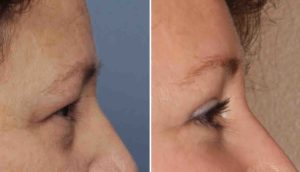Background: While aging affects the whole face it often appears earliest and over time most significantly around the eyes. Excessive skin, fat bulges and wrinkles affect the eyelids and the skin around them. How much excessive skin that develops on the eyelids is a function of a variety of anatomic and genetic factors.
But one contributing factor in how much upper eyelid skin that develops is the position of the eyebrows. Eyebrows that have descended with age pushes down on the upper eyelid skin, creating the perception that more upper eyelid skin exists than what may actually be present. Thus the position of the brows must be considered when upper blepharoplasty is planned. This is more paramount in women than men who can tolerate lower brow positions and are often concerned of having an unnatural result.
In considering a browlift in women, the length of the forehead is a major consideration in what type of browlift is best to perform. If the forehead is excessively long the traditional options of either an endoscopic or coronal browlift will make the forehead longer. This leaves the hairline or pretrichial browlift as the remaining option as it lifts the brows but does not change the frontal hairline or can even make it lower.
Case Study: This female desired to have facial rejuvenation for her tired and heavy eye appearance. Her brows were low for a female and she had thick eyelid skin. Her vertical forehead length was 7cm between the frontal hairline and the mental glabella.


In women with heavy forehead and eyelid tissues getting a visibly rejuvenated eye appearance necessitates a maximal approach in doing so. Heavy brows and over active forehead musculature does not bode well for an upper blepharoplasty alone and can lead to over resected upper eyelid skin.
Case Highlights:
1) Periorbital aging affects both the eyelids and the brows and must be considered as a total unit for rejuvenation efforts.
2) Heavy upper eyelids are often associated with low brows necessitating a browlift to aid the upper blepharoplasty result and guide how much upper eyelid skin to remove.
3) The pretrichial or hairline browlift provides a good lift with open access for muscle resection.
Dr. Barry Eppley
Indianapolis, Indiana





